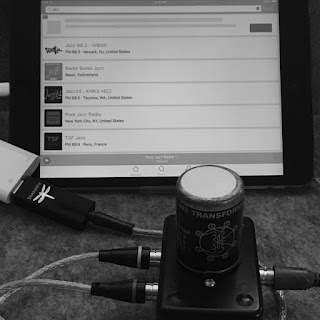The FM tuner has been a de rigeur music source in my audio system. Between the dwindling quality of FM broadcasts and proliferation of internet radio and music streaming apps like Pandora, Spotify, Tidal etc., I had to jump the bandwagon with my first generation iPad mini.
But as I delved into how to get the best sound from the internet, I realized that I could improve upon the iPad mini > USB DAC set up for not much $$s. I've seen Blogs and YouTube videos on how the Raspberry Pi 3B+ (henceforth, RPi3B+), a 40 something dollar single board computer, can be configured as a hi-fi music player.
A discussion of the RPi3B+'s sonic merits in the Joe-list initiated by a long-time audio DIYer, Larry Moore, was pivotal in my decision to try it. He recommended using the RPi3B+ with an I2S Allo Boss DAC, moOde 4.1 + a linear power supply. Since I already had a couple of USB DACs, I just opted for the cheapest RPi3B+ bundle with a 5V/2.5A SMPS (switched-mode power supply), a molded transparent acrylic case and a couple of 16GB micro SD cards from Amazon.
The software for the RPi3B+ is contained in a micro SD card, which is inserted in the bottom mounted front slot. At the back is an ethernet port + 4 USB ports which can be loaded with USB thumb drives filled with music files and/or connected to an outboard DAC. On the right side, there's a mini USB for 5V power, an HDMI port and a 3.5mm below hi-fi grade audio out. 😞 To the left is a 40 pin GPIO header where an I2S S/PDIF device or DAC can be attached, which supposedly offers even better sound due to less jitter.
Once the software is loaded and configured the RPi3B+ will be operating "headless" (no monitor or touch screen). All functions are accessed and operated via a web browser on an iOS/Android device or laptop.
moOde 4.1
 |
| moOde GUI |
Installing moOde 4.1 was not an easy task - not for me, at least. I had to bring the TV near the router to function as an HDMI monitor and plug a USB keyboard on the RPi3B+ to type commands which reminded me of WordStar word processing on an IBM XT/AT in the 80s. After two trials using the EZ install process and valuable assistance from the good guys at Hi-Fi Haven, my moOde 4.1 build was a success.
The only glitch I had with moOde 4.1 is that Airplay doesn't work with the following DACs via USB: AQ Dragonfly Black, XtremPro X1 and Topping D30. So far I can only get moOde 4.1 Airplay to work with the Xiang Sheng DAC 01A below. I'm hoping that an update will address this issue.
Volumio
 |
| Volumio GUI |
After the moOde 4.1 initiation, installing Volumio was a breeze. The software is downloaded as a file, "etched" on a 16GB micro SD card and then set up for Wi-Fi connection. No MS-DOS style typing required. Everything went smoothly even for a not-too-tech-savvy computer user like me. There were no issues with Airplay connection, regardless of which DAC was connected to the USB port. The choice of internet FM radio stations is at par with moOde 4.1 and there's a "plug-in" for YouTube. There's also support for Spotify subscribers. Since I only have a Spotify free membership, I "Airplay" from an iPad.
Sound
I wouldn't have known that the software itself can influence the sound in computer audio if I didn't embark on a Raspberry Pi journey. The more complicated set up procedure and USB > DAC issues notwithstanding, moOde 4.1 rewards the listener with deeper and punchier low frequencies, crisper high frequencies and more lucid midrange. Volumio sounds as if the leading edge of transients are slightly rounded off. The difference is actually quite subtle and only discernible after extended listening to both platforms.
According to MikeyFresh, a moderator at HiFi Haven who helped me a lot with the moOde install, "Moode is a very lean distribution, perhaps that's why it can sound better, it runs super efficiently and thus taxes the RPi3's CPU and RAM very little, which in turn produces less EMI/RFI to contaminate the signal."
 |
| iPad mini as controller, RPi3B+ and Topping D30 DAC |
I'd hate to bid adios to my beloved Scott LT110B and Dyna FM-3 tube tuners, but the RPi 3B+ is getting more air time nowadays.
!!!STOP PRESS!!!
I initially considered the cheaper Hifiberry Digi+ Pro, but based on the positive reports I've read on the internet from RPi users, I took the plunge and got the more expensive Allo Digione S/PDIF HAT (aka Hardware Attached on Top) instead. A layer of electronic hash was removed by this I2S device and took the sound quality to another level = more analog, less digital.







